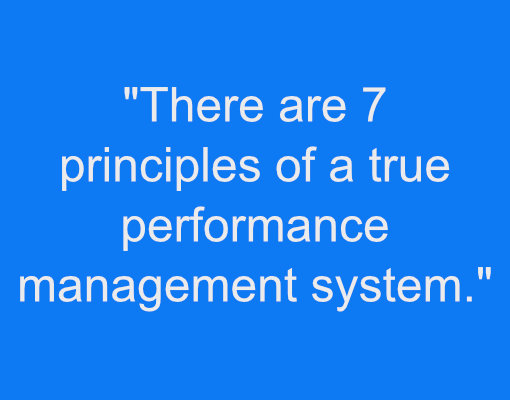Imagine going back to 2008 and the economy is at its worst state since the great depression. You are managing a local government and property taxes don’t come it as expected or the charges for services are down by 25%. What would you do? How would you manage the insufficient with the requirement to serve and keep the community safe with fire protection, water and sewer services and maintain clean cemeteries? Which part of the budget or expenditures would you cut or remove in the current year? I would propose to implement a performance management system within the government. Although a performance government does not shield you or protect you from a drop in revenues but it will help in choosing which areas or programs to cut and which to keep. More importantly it provides a transparent and more efficient way of operating a government which gives greater comfort to the public.
What is performance management?
Performance management in the public sector is an ongoing, systematic approach to improving results through evidence-based decision-making, continuous organizational learning, and a focus on accountability for performance. Performance management is integrated into all aspects of an organization’s management and policy-making processes, transforming an organization’s practices so it is focused on achieving improved results for the public.*

In the past, larger local or state governments were only able to implement performance management due to the need to have system driven data readily available and many smaller local or state governments did not have the expertise or the capability to implement it. Thankfully due to improvements in technology smaller local or state governments can now implement performance management. We’ll learn the steps to implement performance management, the benefits, and why performance management makes way for a government to always improve its service(s) and understand the wants of the community.
* “A Performance Management Framework for State and Local Government: From Measurement and Reporting to Management and Improving.” National Performance Management Advisory Commission. Government Finance Officers Association. 2010. Page viii.
http://www.gfoa.org/sites/default/files/APerformanceManagementFramework.pdf

What do you need to start practicing performance management? At a high level here is what you need:
- Structure data in a way to analyze and create relationships between operations and finance
- Centralize financial and operational data in a single platform
- Create performance measures
- Create benchmarks to services to gauge or analyze performance over time
- Identify short, medium, and long-term outcomes and align them with key performance indicators (KPIs)
- Track data over time
- Analyze the data to create relationships between the operational and financial data
- Perform a cost-benefit analysis
- Survey the community for their wants and needs
- Evaluate spending with the outcomes (the actual service)
- Decision Making and Resource Allocation
- Use your plans, desired outcomes (the actual services) to create the budget. The budget is dependent upon #1, #2, and #3, and #4.
The reason for performance management is to have an ongoing process to improve your understanding of the public needs/wants, implement outcomes to meet those needs/wants, improve those services, and in hard economic times have evidence to support a decision on facts from previous and current periods. In addition, it allows for transparency as each decision is based upon the data both current and historic. Please, note implementing performance management does not happen overnight. Nor is it a one time project. Performance management is ongoing and ever-changing. This is why a government that utilizes performance management will be better equipped to make the “hard” decision during an economic downturn because the Management and Board will have data to back their decision(s).
PRINCIPLES OF PERFORMANCE MANAGEMENT
There are 7 principles of a true performance management system. These include:
- A results focus creates strategies, processes, culture and decisions
- The well-being of the government and community is dependent on information, measures, goals, priorities, and activities
- The information is transparent
- Goals, programs, activities, and resources are aligned with priorities and desired results
- Decisions and processes are driven by timely, accurate, and meaningful data
- Practices are sustainable over time and across organizational changes
- Performance management transforms or improves the organization, its management, and the policy-making process

RESULT FOCUSED
A results focus is the pillar of performance management. The reason for the approach is to focus its attention more on the needs of the community rather solely working on compliance, fairness, etc of the process.
Traditionally, government processes and practices revolve around compliance and fairness. Performance management not only incorporates compliance and fairness but also adds how the government will achieve its goals. At its core, the government is in place to meet the needs of the community and without a “results focused” process the government can’t 100% ensure the needs are being met.
Focusing on results brings transparency to decision-making. The decision-making will be through key performance indicators, surveys of the community, actual financial and operational data rather than on a more subjective methodology.

PRIORITIES , WELL-BEING, AND EASY ACCESS
Performance management requires for the organization to create goals and plans to meet the community needs and wants. An organization will not plan or have a goal unless it is in the best interest of the community. No budget should be approved unless it can somehow prove the expenditures (inputs) will create outcomes (the services) which will ultimately fulfill the community’s needs and wants.
For example, the fire department may invest in a new GPS system. The GPS will aid the firefighters in arriving to the destination without getting lost. The saved time will help the community, therefore, this budgeted line item (GPS System) attributes to the goals of the fire department in arriving at the destination in 5 minutes or less, and improves the outcome and the community.
Transparency is a “hot” topic in the government industry. The greater the transparency the more the trust of the community. Performance management allows providing reasons for making decisions. The readily available information assists management to make a more sound decision and communicate the decision to the Board and the community.
For example, if a local government facing shutting down a program, the decision to shut down one program over the other will be based on the program that serves the community the least. In other words, the program that does not impact the community as much will be the program to be cut or stopped.
Please, note the information should be organized in a way to easily understand. There is nothing worse than not understanding the information and how it is organized. This is why a good management information system is so important.
PRIORITIES , DECISIONS, AND PRACTICES
Performance management done right will align, goals, programs, activities, and resources with priorities and desired results. How does a government know what is a priority or desired result? Its through the surveys conducted of the community, the best government practices, and internal data. Alignment is key for the success of the government. If there is not alignment the government will possibly act like two organizations with competing priorities or goals.
Management must have data to make a decision. They must have data over a long period and learn to understand when the data is suggesting to make a change in a metric (measure) or a change in the community wants or needs.
The organization needs to focus on process improvement. Performance management won’t be effective or successful unless the whole organization from the bottom up has a mind-set to improve. Remember the first principle, Results Driven? The organization needs to have processes in place to perform at its best also a change management system to know when its best to change a process.
Furthermore, when an organization is effectively using performance management, it will transform the organization, its management and policy-making process. The way the organization will run is completely different than of a traditional government. It will focus more on results and how the services impact the community rather than only on inputs and outputs (i.e. expenditures and services)
PERFORMANCE MANAGEMENT IMPLEMENTATION
If you are familiar with internal controls, you are familiar with the “tone at the top“. This is a concept that the Board and upper management needs to believe in performance management before anything can be implemented.
After upper management and the Board fully believe in performance management, the next step is to brain storm as to the reason for the change in management methodology. You’ll need to clarify the purpose or purposes and establish key objectives to help you determine the process design. Next, choose which performance management system approach the government will take. There are many systems (i.e. balanced scorecard, stat system, your own unique system, etc)

Whichever management system approach you use, it will be followed by a planning process. In this stage, you’ll create strategic priorities. The strategic priorities will align long-term objectives, annual targets, and strategies.
After you create strategic priorities, then you’ll create a process to engage with the community to understand their needs and wants. An effective performance management system can only work if the government knows how to fulfill or improve the community’s needs and wants. It is vital for the government to receive accurate information from the public and know how to analyze the internal data to move toward a result orientated organization.
After you have collected the data from the public and analyzed what needs to be done to improve the process to meet the community’s needs, a budget process needs to be created. This budget process will focus on the goals and priorities of the organization. The performance management system focuses on the community’s needs first and bases the programs and activities set-forth in a budget on the needs. What activity or program will make the greatest impact to the Community. These activities and programs will be found first on the budget and for those programs and activities with less of an impact, they won’t have priority. Can you see how the budget process is different from an incremental budget process looking at the prior year expenditures and creating the budget?
After a budget is created, you’ll need to set metrics in place to validate actual results. These metrics will be used to compare how well the government is doing in comparison to fulfilling the community’s needs and wants. These metrics will be based on best practices and internal data accumulated in your management information system. Furthermore, you’ll need a person or group to be in charge of this process and a process to ensure the data collected is accurate, reliable, and available to all stakeholders. In addition, the organization needs to have the ability to analyze the data and interpret it in a way to help the organization make decisions.

Managing the Change
To implement the approach correctly, you’ll need a management process to assess your government’s capacity for change, assess the risks, create a change management process, implement a process for communication, train the employees the reasons for the change and how to educate on how each employee fits in this new management system, and celebrate success.
Irrespective of the plan and strategy of your government, there will be those that are for and those that are against the new plan or strategy. Make sure you have a process to respond to the resistance both positive and negative. Also, consider creating a success plan where key individuals, groups, or the organization can celebrate.

MAINTAINING PERFORMANCE MANAGEMENT
This management style or method is not static but evolves over time. To have a successful performance management process your government or organization will need a supportive “tone at the top”, supportive employees, expertise in evaluating performance (This can be gained overtime), and external resources to help with evaluating and transitioning. For example, your government can reach out to other organizations to understand how they transitioned and maintain a performance management system. The Board and upper management will need to be 100% into transitioning this management method, because it does take initial investment of cash to implement this method. Learning new skills, buying new equipment, creating change management processes and a plan to respond to resistance takes time and cash. In the long-run performance management will save time and money plus give the public a better service.
The performance management cycle is as follows:
- Planning
- Budgeting
- Management
- Evaluation
The planning cycle normally is a long-term or medium-term plan between 2-5 years. Budgeting normally is shorter in nature between 1-2 years. Management is the day to day supervision of operations, and evaluation is the stage where you measure goals, targets, feedback with actual results.
FINAL THOUGHTS
Well, what do you think? Do you think this method of managing your government will help in the long-term? Many governments have benefited from performance management. Given there are many types in existence in the United States. Many times not each government operate or can operate in the same way thus this style of managing operations will differ government by government.
If you would like to learn more about performance management, consider reading ‘The State and Local Government Performance Management Sourcebook’ by Anne Spray Kinney and Michael J Mucha and ‘A Performance management Framework for State and Local Government: From Measurement and Reporting to Management and Improving by the National Performance Management Advisory Commission.
We covered performance management at a high-level. If you are interested in implementing performance management, do your research and start by reading the two books I provided above. Not only do these resources give a step by step process but also incorporate real life examples of state and local governments transition to performance management and their ongoing operations. To borrow the colloquial phrase, “at the end of the day”, we should always be thinking about how to improve and make our community a better place to live and visit.
If you have any questions or comments, please give us a call at (408) 780-2236 or email us at david@dfarnsworthcpa.com. Have a great day!
David Farnsworth, CPA
P.S. We are on a mission to help local governments with fraud prevention and governmental finance. We exist to help eliminate abuse, wasteful spending and fraud. Our goal is to help you run a transparent financially responsible District or Agency. When you’re ready, here are a few ways we can help right away:
- Sign-up to our monthly newsletter here. We cover topics ranging from fraud prevention, financial reporting, government budgeting, etc.
- Take our fraud risk assessment (link to assessment here) We’ll give you specific recommendations on how to improve your situation right away.
- Receive our free fraud prevention package (click this link to schedule a meeting)
- Jump on a video conference call to get specific fraud prevention recommendations (click this link to schedule a meeting).
- Request a proposal to perform the financial audit. request for proposal.

